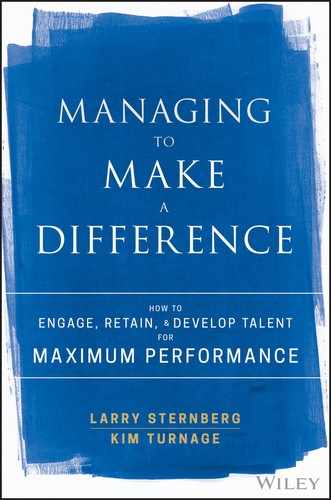Chapter 56
Address Poor Performance
As much as people value fun, they know they have a job to do, and they want a manager who balances fun with a focus on performance. Top performers thrive in a culture of clear expectations and accountability. Confident in their capabilities, they are motivated by challenges that require them to stretch and by goals that are difficult to achieve. They want to know their supervisor believes they are capable of achieving goals that others cannot. They also crave the intrinsic satisfaction experienced when they attain those goals. In fact, some top performers thrive on doing things others say can't be done. The more clarity you can bring to expectations, the easier it is for everyone. Ideally, there are objective metrics attached to the expectations you set so that, as a manager, you can hold people accountable for meeting them and provide recognition and rewards when they do. Recognize that top performers expect you both to reward people who meet and exceed performance expectations and to address poor performance with people who fail to meet those same expectations.
If your goal is managing to make a difference, start by establishing clear goals and choosing the right metrics to assess performance. Answer these questions:
- “If X is performing with excellence in this role, how will we know it?”
- “What will we see happening? What will we not see happening?”
Sometimes identifying the right metrics is difficult. In the absence of metrics, the person must rely solely on your qualitative feedback as a manager. Whether you have metrics or must rely on more subjective assessments, make sure you are giving people frequent, candid feedback about their performance.
Accountability must be accompanied by empowerment. If you are going to hold people accountable for meeting certain expectations, you must allow them to decide how they will go about achieving those results. If an employee or a team is merely carrying out your directions about the how, you are the owner of the results, not them, and you cannot legitimately hold them accountable for those results. Make sure you empower people to the same extent you want to hold them accountable for results.
When you have the metrics, feedback, empowerment, and accountability right, poor performance becomes obvious. In most cases of poor performance, the employee knows that there is a problem even before you do. It is not kind or helpful to leave someone in a situation in which he or she is failing. Everyone knows there is a performance problem. You know there is a performance problem. And in many cases, everyone on the team knows there is a performance problem because they are picking up the slack in some way. Your team members and especially your top performers want you to address it. Performance matters to them. They will lose respect for you as a manager if you do not deal with poor performance.
Determining the consequences for poor performance is not always straightforward. Consequences must be tailored to suit the situation. Managers can easily err on both sides of this issue. This is where some art comes in. If you continue to accept excuses for not meeting expectations, you wind up carrying unproductive people, thereby negatively affecting your customers, your employees, and your company. On the other hand, everyone screws up from time to time. If you react too harshly, you can lose an employee who can add a great deal of value over time. When you are addressing poor performance, all of your employees are watching. They will correctly conclude that you will deal with them similarly if they find themselves in a similar situation. Be thoughtful about what message you are sending, but do not blindly follow policies and procedures or respond in exactly the same way to every situation.
The root cause for each instance of failure must be considered. Here are some questions you can ask that might help you understand why poor performance exists, so you can address it in the most effective ways:
- Did the employee fail to put in enough effort?
- Did he or she have the right training and resources?
- Did the employee know what was expected?
- Do the expectations align with the employee's strengths?
- When this person encountered a problem, did he or she bring it to someone's attention and seek help?
- Is this failure an anomaly or is this a well-established pattern?
- Was there an unforeseeable event that had a material impact on this person's ability to achieve the goals?
It is important to hold people accountable. But it is also important to ensure that the consequences are thoughtfully tailored to each situation.
